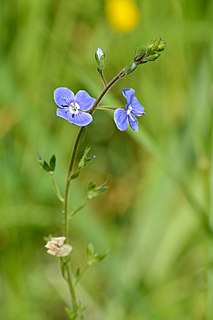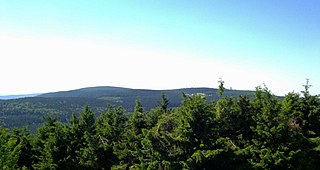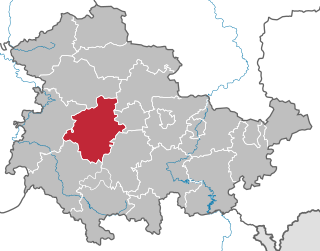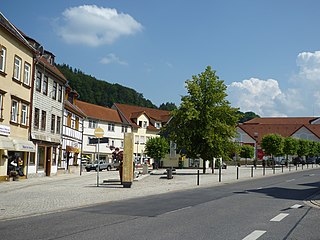| Großer Finsterberg | |
|---|---|
 View from Kalter Staudenkopf (768 m) of the Großer (944 m, half right) and Kleiner (875 m, right) Finsterberg. Half left is the Schneekopf (978 m) and its subpeak, the Teufelskreise (967 m, in front) with the Schmücke (just below, pasture) and Fichtenkopf (944 m, to its left). The pasture below lies at the foot of the Großer Eisenberg (907 m, on the left, hidden). In the central foreground is the Volkmarskopf (726 m). | |
| Highest point | |
| Elevation | 944.1 m above sea level (NHN) (3,097 ft) |
| Prominence | 122 m ↓ Mordfleck |
| Isolation | 3.8 km → Teufelskreis (Schneekopf) |
| Coordinates | 50°38′17″N10°48′06″E / 50.63806°N 10.80167°E Coordinates: 50°38′17″N10°48′06″E / 50.63806°N 10.80167°E |
| Geography | |
| Parent range | Thuringian Forest |
| Climbing | |
| Normal route | Along the L 2615 between Schmiedefeld/R. and Oberhof |
 | |
The Großer Finsterberg is a mountain, 944.1 m above NHN, [1] in the Thuringian Forest not far from the villages of Stützerbach and Schmiedefeld am Rennsteig. It is the third highest peak in the German state of Thuringia.

A mountain is a large landform that rises above the surrounding land in a limited area, usually in the form of a peak. A mountain is generally steeper than a hill. Mountains are formed through tectonic forces or volcanism. These forces can locally raise the surface of the earth. Mountains erode slowly through the action of rivers, weather conditions, and glaciers. A few mountains are isolated summits, but most occur in huge mountain ranges.

The Thuringian Forest, is a mountain range in the southern parts of the German state of Thuringia, running northwest to southeast between the valley of the river Werra near Eisenach and the Thuringian-Vogtlandian Slate Mountains. The geographical boundary with the latter range follows approximately a line from Gehren via Großbreitenbach to Schönbrunn near Schleusingen, defined by the rivers Schleuse and Neubrunn on the southwestern slope, and Talwasser, Wohlrose and Möhre on the northeastern slope.

Stützerbach is a village and a former municipality in the Ilm-Kreis district, in Thuringia, Germany. Since 1 January 2019, it is part of the town Ilmenau.





















